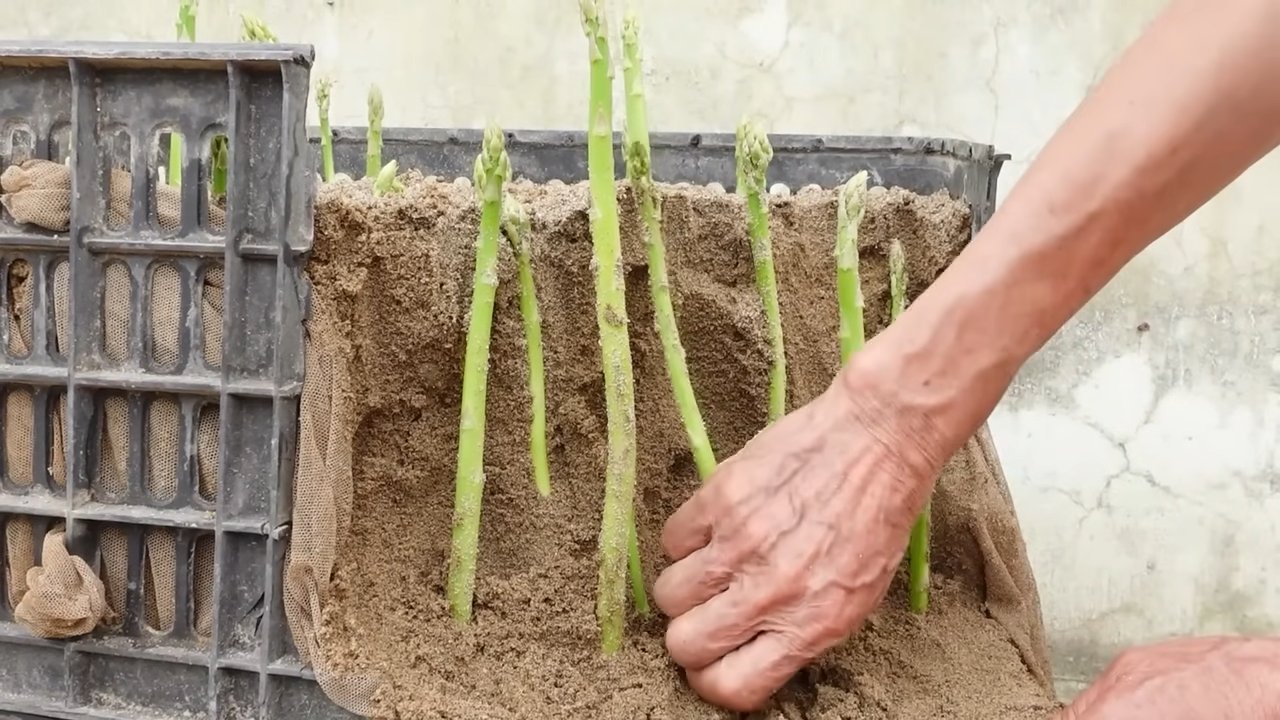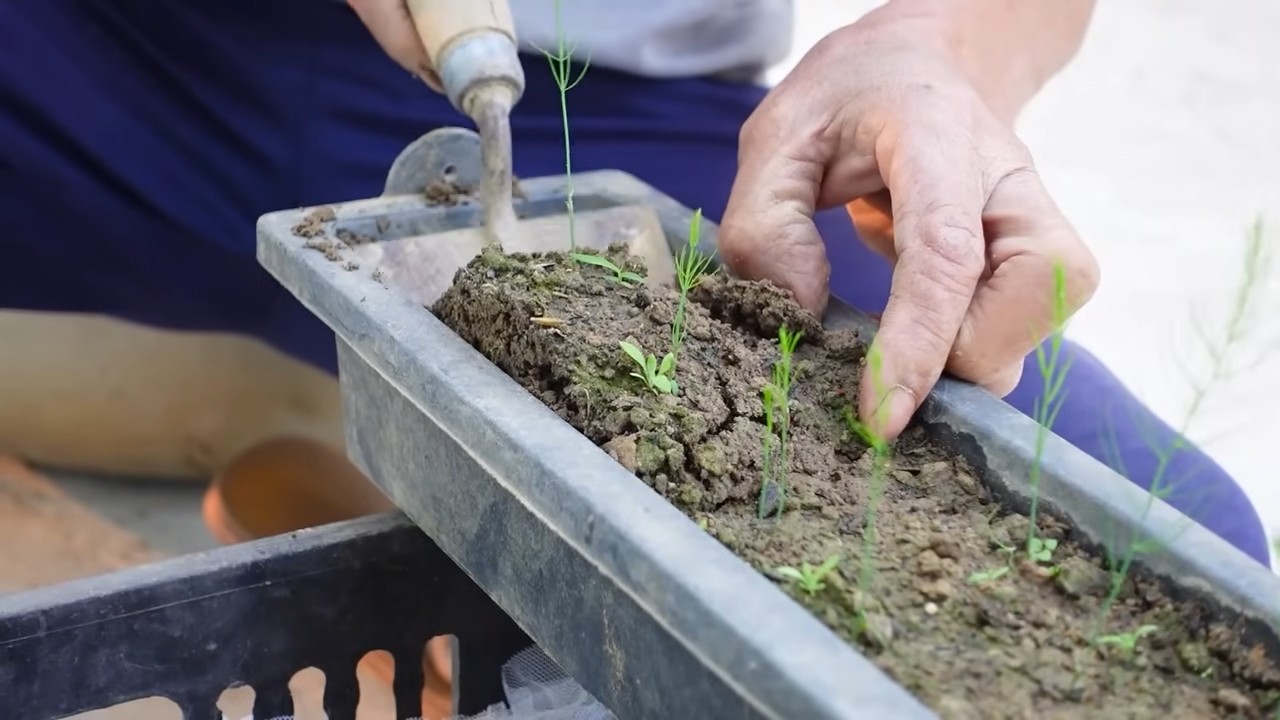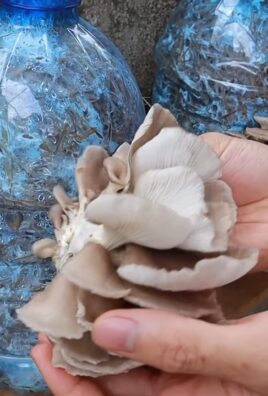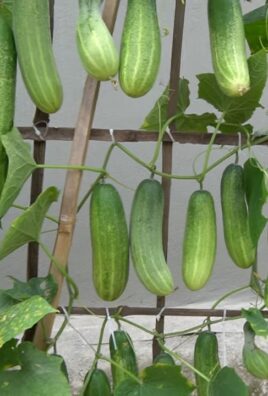Growing Asparagus at Home might seem like a challenge reserved for seasoned gardeners, but I’m here to tell you it’s totally achievable, even if you’re a beginner! Imagine stepping into your backyard and harvesting your own tender, delicious asparagus spears – fresher and tastier than anything you’ll find at the grocery store. Sounds dreamy, right?
Asparagus has a rich history, dating back to ancient Greece and Rome, where it was prized for its medicinal properties and delicate flavor. The Romans even developed sophisticated cultivation techniques to ensure a steady supply of this coveted vegetable. Today, while we may not need it for its medicinal benefits as much, the joy of nurturing and harvesting your own food remains a deeply satisfying experience.
Why should you try growing asparagus at home? Well, for starters, commercially grown asparagus often travels long distances, losing flavor and nutrients along the way. Plus, let’s be honest, it can be quite expensive! But more importantly, this DIY project offers a unique opportunity to connect with nature, learn about the growing process, and enjoy the unparalleled taste of homegrown goodness. This article will provide you with simple, step-by-step instructions and insider tips to successfully cultivate your own asparagus patch, transforming your garden into a source of fresh, healthy, and delicious spears for years to come. Get ready to dig in!

Growing Asparagus at Home: A Beginner’s Guide
Asparagus, that delectable spring vegetable, is often seen as a gourmet treat. But guess what? You don’t need to rely on expensive grocery store prices to enjoy it. You can grow your own asparagus right in your backyard! It might seem daunting at first, but with a little patience and the right know-how, you can harvest fresh, flavorful asparagus spears for years to come. This guide will walk you through everything you need to know, from choosing the right variety to harvesting your first crop. Let’s get started!
Choosing Your Asparagus Variety
Before you even think about digging, you need to decide which asparagus variety is right for you. Different varieties have different characteristics, such as disease resistance, spear size, and yield. Here are a few popular choices:
* ‘Jersey Knight’: This is a widely popular, all-male hybrid known for its high yields and disease resistance. All-male varieties are preferred because they don’t produce seeds, which can weaken the plant and reduce spear production.
* ‘Jersey Giant’: Similar to ‘Jersey Knight,’ but with slightly larger spears. It’s also an all-male hybrid and a reliable producer.
* ‘Purple Passion’: This variety is unique because its spears are a beautiful deep purple color. They turn green when cooked, but they’re a fun and flavorful addition to any garden. It’s also known for being sweeter than green varieties.
* ‘Millennium’: A relatively new variety that’s gaining popularity for its excellent disease resistance and high yields.
Consider your climate and soil conditions when making your choice. Local nurseries can offer valuable advice on which varieties thrive in your area.
Preparing Your Asparagus Bed
Asparagus is a perennial, meaning it will come back year after year. Because of this, it’s crucial to choose a location and prepare the soil carefully. This is a long-term investment, so take your time and do it right!
* Sunlight: Asparagus needs at least 6-8 hours of sunlight per day. Choose a location that gets plenty of sun throughout the growing season.
* Soil: Asparagus prefers well-drained soil that’s rich in organic matter. Sandy loam is ideal, but you can amend heavier clay soils to improve drainage.
* Drainage: Good drainage is essential to prevent root rot. Avoid areas where water tends to pool after rain.
* Space: Asparagus plants can get quite large over time, so give them plenty of space. Allow at least 4 feet between rows and 1-2 feet between plants within a row.
* Weed Control: Clear the area of all weeds, grasses, and other vegetation. Asparagus doesn’t compete well with weeds, especially when it’s young.
Planting Asparagus Crowns
Asparagus is typically grown from crowns, which are one-year-old dormant plants. You can purchase crowns from nurseries or online retailers.
1. Timing: The best time to plant asparagus crowns is in early spring, as soon as the soil can be worked.
2. Dig Trenches: Dig trenches that are 6-8 inches deep and 12 inches wide. Space the trenches 4 feet apart.
3. Amend the Soil: Mix compost or well-rotted manure into the soil at the bottom of the trench. This will provide nutrients and improve drainage.
4. Plant the Crowns: Place the asparagus crowns in the trench, spacing them 1-2 feet apart. The crowns should be positioned with the buds facing upwards.
5. Cover the Crowns: Cover the crowns with 2-3 inches of soil. Water thoroughly.
6. Gradually Fill the Trench: As the asparagus shoots emerge, gradually fill in the trench with soil. This will encourage the plants to develop a strong root system. Over the course of the first growing season, you’ll completely fill the trench.
Caring for Your Asparagus Plants
Once your asparagus plants are in the ground, they’ll need regular care to thrive.
* Watering: Water deeply and regularly, especially during dry periods. Asparagus needs consistent moisture to produce healthy spears.
* Fertilizing: Fertilize your asparagus plants in early spring with a balanced fertilizer. You can also side-dress with compost or well-rotted manure.
* Weed Control: Keep the area around your asparagus plants free of weeds. Mulching can help suppress weed growth and retain moisture.
* Pest and Disease Control: Asparagus is relatively pest-resistant, but watch out for asparagus beetles and aphids. Treat infestations with insecticidal soap or neem oil. Common diseases include rust and crown rot. Choose disease-resistant varieties and ensure good drainage to prevent these problems.
* Mulching: Apply a layer of mulch around your asparagus plants to help retain moisture, suppress weeds, and regulate soil temperature. Organic mulches like straw, wood chips, or shredded leaves are ideal.
Harvesting Your Asparagus
Patience is key when it comes to harvesting asparagus. You shouldn’t harvest any spears during the first two years after planting. This allows the plants to establish a strong root system.
1. Year 3: In the third year, you can harvest spears for a short period, about 2-3 weeks.
2. Year 4 and Beyond: In the fourth year and beyond, you can harvest spears for a longer period, about 6-8 weeks.
3. Harvesting Technique: Harvest spears when they are 6-8 inches tall and about as thick as your finger. Cut the spears at ground level with a sharp knife.
4. Stop Harvesting: Stop harvesting when the spears become thin and spindly. This indicates that the plants are starting to weaken.
5. Fern Development: Allow the remaining spears to grow into ferns. These ferns will nourish the plants and help them store energy for the next growing season.
Fall Maintenance
After the harvesting season is over, it’s important to prepare your asparagus plants for winter.
1. Cut Back Ferns: In late fall or early winter, after the ferns have turned brown, cut them back to ground level.
2. Clean Up Debris: Remove any fallen leaves or other debris from the asparagus bed. This will help prevent disease.
3. Mulch: Apply a fresh layer of mulch to protect the crowns from freezing temperatures.
4. Fertilize (Optional): You can apply a light application of fertilizer in the fall to replenish nutrients in the soil.
Troubleshooting Common Problems
Even with the best care, you may encounter some problems when growing asparagus. Here are a few common issues and how to address them:
* Thin Spears: Thin spears can be caused by several factors, including lack of water, poor soil fertility, or over-harvesting. Make sure your plants are getting enough water and nutrients, and avoid harvesting for too long.
* Asparagus Beetles: Asparagus beetles are small, colorful beetles that can damage asparagus spears and ferns. Handpick the beetles or spray with insecticidal soap or neem oil.
* Rust: Rust is a fungal disease that causes orange or brown spots on the ferns. Choose disease-resistant varieties and ensure good air circulation to prevent rust.
* Crown Rot: Crown rot is a fungal disease that causes the crowns to rot. Ensure good drainage to prevent crown rot.
Enjoying Your Homegrown Asparagus
After all your hard work, it’s time to enjoy the fruits (or vegetables!) of your labor. Freshly harvested asparagus is incredibly flavorful and versatile. Here are a few ideas for how to use it:
* Steamed: Steaming asparagus is a simple and healthy way to prepare it.
* Roasted: Roasting asparagus brings out its natural sweetness.
* Grilled: Grilled asparagus is a delicious addition to any barbecue.
* Sautéed: Sautéed asparagus is a quick and easy side dish.
* In Salads: Add asparagus to salads for a burst of flavor and nutrients.
* In Soups: Asparagus can be used to make creamy and flavorful soups.
* In Frittatas and Omelets: Add asparagus to frittatas and omelets for a healthy and delicious breakfast or brunch.
Growing your own asparagus is a rewarding experience that will provide you with fresh, flavorful vegetables for years to come. With a little patience and the right care, you can enjoy the taste of homegrown asparagus right from your backyard. Happy gardening!

Conclusion
So, there you have it! Growing asparagus at home isn’t just a gardening project; it’s an investment in years of delicious, fresh harvests right from your backyard. Forget those limp, overpriced spears at the grocery store. Imagine stepping outside and snipping vibrant, tender asparagus whenever you crave it. The flavor difference alone is enough to convince anyone to give it a try.
This DIY approach to growing asparagus offers a level of control and satisfaction you simply can’t get from buying it. You know exactly what’s going into your food – no pesticides, no long-distance transportation, just pure, homegrown goodness. Plus, establishing an asparagus bed is a long-term commitment that yields rewards for decades to come. Think of it as planting a family heirloom that keeps on giving.
But the benefits extend beyond just the taste and quality. Gardening is a fantastic way to connect with nature, reduce stress, and get some exercise. Tending to your asparagus bed can become a meditative ritual, a chance to unwind and appreciate the simple pleasures of life. And let’s not forget the bragging rights! Imagine serving a dish featuring asparagus you grew yourself. Your friends and family will be impressed, and you’ll feel a sense of accomplishment that’s hard to beat.
Now, while we’ve focused on the traditional method of planting crowns, don’t be afraid to experiment! Some gardeners have success starting asparagus from seed, although it requires more patience. You can also explore different varieties of asparagus to find the ones that best suit your taste and climate. Consider adding companion plants like tomatoes or basil to your asparagus bed to deter pests and improve soil health.
And speaking of soil, remember that well-drained, nutrient-rich soil is key to success. Amend your soil with plenty of compost and organic matter before planting, and continue to feed your asparagus bed regularly with a balanced fertilizer. Proper watering is also crucial, especially during the first few years as the plants establish themselves.
Don’t be discouraged if you don’t see a harvest right away. Asparagus needs time to mature before you can start cutting spears. Patience is a virtue when it comes to growing asparagus, but the wait is well worth it. In the meantime, enjoy watching your plants grow and knowing that you’re creating a sustainable source of delicious food for years to come.
We wholeheartedly encourage you to embark on this rewarding gardening adventure. Growing asparagus at home is a truly fulfilling experience, and we’re confident that you’ll love the results. So, grab your gardening gloves, prepare your soil, and get ready to enjoy the freshest, most flavorful asparagus you’ve ever tasted.
Once you’ve harvested your first crop, we’d love to hear about your experience! Share your tips, tricks, and photos with us in the comments below. Let’s build a community of asparagus enthusiasts and inspire others to grow their own food. Happy gardening!
Frequently Asked Questions (FAQ)
What is the best time of year to plant asparagus?
The ideal time to plant asparagus crowns is in early spring, as soon as the ground can be worked. This allows the plants to establish themselves before the heat of summer arrives. In warmer climates, you can also plant in the fall. The key is to avoid planting when the ground is frozen or waterlogged. If you are starting from seed, you will need to start them indoors 8-10 weeks before the last expected frost.
How much space does each asparagus plant need?
Asparagus plants need plenty of space to spread out. When planting crowns, space them about 12-18 inches apart in rows that are 4-5 feet apart. This will give the plants enough room to grow and prevent overcrowding. If you are planting in a raised bed, you can space them slightly closer together, but make sure they still have adequate room to develop.
How long does it take for asparagus to produce a harvest?
Patience is key when growing asparagus. It typically takes 2-3 years after planting crowns before you can start harvesting spears. During the first year, allow the plants to grow undisturbed so they can develop a strong root system. In the second year, you can harvest a few spears, but only for a short period of time. By the third year, you can harvest more heavily, but always leave some spears to fern out and replenish the plant’s energy reserves. If you start from seed, it will take even longer, usually 3-4 years, before you can harvest.
What kind of soil is best for growing asparagus?
Asparagus thrives in well-drained, sandy loam soil that is rich in organic matter. The soil should have a pH of 6.5 to 7.5. Before planting, amend the soil with plenty of compost, aged manure, or other organic materials to improve drainage and fertility. Asparagus does not tolerate heavy clay soil, so if your soil is clay-based, consider growing asparagus in raised beds or containers.
How often should I water asparagus plants?
Asparagus plants need consistent moisture, especially during the first few years as they establish themselves. Water deeply and regularly, especially during dry periods. Avoid overwatering, as this can lead to root rot. A good rule of thumb is to water when the top inch of soil feels dry to the touch. Once the plants are established, they are more drought-tolerant, but still benefit from regular watering.
What are some common pests and diseases that affect asparagus?
Asparagus beetles are a common pest that can damage asparagus spears and foliage. Handpicking the beetles or using insecticidal soap can help control them. Asparagus rust is a fungal disease that can cause orange or brown pustules on the stems and foliage. Proper spacing and good air circulation can help prevent rust. Fusarium wilt is another fungal disease that can cause the plants to wilt and die. Planting disease-resistant varieties and practicing crop rotation can help prevent Fusarium wilt.
How do I harvest asparagus spears?
Harvest asparagus spears when they are about 6-8 inches tall and about as thick as your finger. Use a sharp knife to cut the spears at ground level. Avoid cutting too close to the crown, as this can damage the plant. Harvest spears regularly during the harvest season, which typically lasts for 6-8 weeks in the spring. As the harvest season progresses, the spears will become thinner and less tender.
How do I care for asparagus plants after the harvest season?
After the harvest season, allow the asparagus plants to fern out and grow tall. The ferns will help replenish the plant’s energy reserves for the following year. Fertilize the plants with a balanced fertilizer in late spring or early summer. Remove any dead or diseased foliage in the fall. In colder climates, mulch the asparagus bed with straw or leaves to protect the crowns from freezing temperatures.
Can I grow asparagus in containers?
Yes, you can grow asparagus in containers, but you will need a large container that is at least 18 inches deep and wide. Use a well-draining potting mix that is rich in organic matter. Plant one or two asparagus crowns per container. Water regularly and fertilize every few weeks. Container-grown asparagus may not produce as many spears as plants grown in the ground, but it is a good option for gardeners with limited space.
What are some good companion plants for asparagus?
Several plants can benefit asparagus when planted nearby. Tomatoes, basil, parsley, and marigolds are all good companion plants for asparagus. Tomatoes help deter asparagus beetles, while basil and parsley attract beneficial insects that prey on asparagus pests. Marigolds repel nematodes, which can damage asparagus roots. Avoid planting asparagus near onions, garlic, or potatoes, as these plants can inhibit asparagus growth.




Leave a Comment